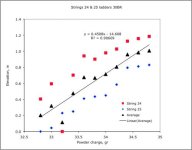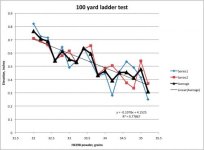M
mks
Guest
I have theorized about tuning by modifying the stock before, so I would like to show some results that demonstrate that it works. First, the graph below shows the rise in point of impact (POI) at 100 yards with increasing powder charge with my old McMillan stock after I installed a recoil pad, but before further modifications. It had about half a pound of lead glued into the buttstock about midway between the heel and toe.

Note that the regression equation shows that POI rises on average about 0.45" per grain of H4198. With variation in muzzle velocity among shots in a group, this contributes to vertical dispersion, and it would be nice to tune the rifle to eliminate this dispersion.
Varmint Al's animations of a recoiling rifle show that the wrist deflects downward, which allows the action to rotate counterclockwise, which eventually whips the muzzle angle upward, allowing slower bullets to exit the muzzle with a higher trajectory. My hypothesis was that the weight in my gun being fairly low in the buttstock might be causing the wrist to deflect upward, or at least not deflect downward quickly enough to force the necessary muzzle motion to compensate for muzzle velocity variations. So I dug out the original weight, and because the rifle was significantly under HV weight limits, added more weight, all as high as possible in the butt. I was not so disciplined as to measure everything precisely, but the main weight was made by filling about 6" of 1" copper tubing with molten lead and gluing this tube directly to the skin of the buttstock inside the heel. Probably about one pound total. To bring the rifle up to just below the HV limit, I glued a few more ounces of lead just below the main weight. Below is the POI with variations in powder charge for the modified rifle. POI at 100 yards falls about 0.11" per grain of H4198.

Sometimes it is better to be lucky than good, but this response is almost perfect for compensating for different muzzle velocities at 200 yards. Slower bullets strike the 100 yard target higher, but converge to almost the same POI as faster bullets at 200. Calculated from the regression equation and external ballistics of a typical 30BR bullet, a group with ES of 50 fps should have vertical dispersion at 200 yards of just 0.0074," not counting other sources of error.
This was confirmed at Gallatin this past weekend, when I tried a very low load of 32.8 gr of H4198 (bad mistake) and had to finish my last two targets at 200 with my old load of 34.6 gr. Between these two loads, there was no detectable change in elevation at 200.
I can't really say whether the hypothesis is proven about wrist motion, because wrist motion was not measured. But what showed up on the target suggests that rifle dynamics were favorably changed without modifying the barrel in any way. Just another alternative to muzzle devices and barrel contours like Tim shared.
An interesting question now is whether a moveable weight system could be devised to adjust the range of convergence from 200 yards to 100 yards. Seems like moving the weight downward, but not all the way down to the midpoint, might do this.
I am just a rookie BR shooter, but it has been fun applying some engineering principles to rifle tuning. Comments and advise welcome.
Cheers,
Keith
Note that the regression equation shows that POI rises on average about 0.45" per grain of H4198. With variation in muzzle velocity among shots in a group, this contributes to vertical dispersion, and it would be nice to tune the rifle to eliminate this dispersion.
Varmint Al's animations of a recoiling rifle show that the wrist deflects downward, which allows the action to rotate counterclockwise, which eventually whips the muzzle angle upward, allowing slower bullets to exit the muzzle with a higher trajectory. My hypothesis was that the weight in my gun being fairly low in the buttstock might be causing the wrist to deflect upward, or at least not deflect downward quickly enough to force the necessary muzzle motion to compensate for muzzle velocity variations. So I dug out the original weight, and because the rifle was significantly under HV weight limits, added more weight, all as high as possible in the butt. I was not so disciplined as to measure everything precisely, but the main weight was made by filling about 6" of 1" copper tubing with molten lead and gluing this tube directly to the skin of the buttstock inside the heel. Probably about one pound total. To bring the rifle up to just below the HV limit, I glued a few more ounces of lead just below the main weight. Below is the POI with variations in powder charge for the modified rifle. POI at 100 yards falls about 0.11" per grain of H4198.
Sometimes it is better to be lucky than good, but this response is almost perfect for compensating for different muzzle velocities at 200 yards. Slower bullets strike the 100 yard target higher, but converge to almost the same POI as faster bullets at 200. Calculated from the regression equation and external ballistics of a typical 30BR bullet, a group with ES of 50 fps should have vertical dispersion at 200 yards of just 0.0074," not counting other sources of error.
This was confirmed at Gallatin this past weekend, when I tried a very low load of 32.8 gr of H4198 (bad mistake) and had to finish my last two targets at 200 with my old load of 34.6 gr. Between these two loads, there was no detectable change in elevation at 200.
I can't really say whether the hypothesis is proven about wrist motion, because wrist motion was not measured. But what showed up on the target suggests that rifle dynamics were favorably changed without modifying the barrel in any way. Just another alternative to muzzle devices and barrel contours like Tim shared.
An interesting question now is whether a moveable weight system could be devised to adjust the range of convergence from 200 yards to 100 yards. Seems like moving the weight downward, but not all the way down to the midpoint, might do this.
I am just a rookie BR shooter, but it has been fun applying some engineering principles to rifle tuning. Comments and advise welcome.
Cheers,
Keith
Attachments
Last edited by a moderator:



